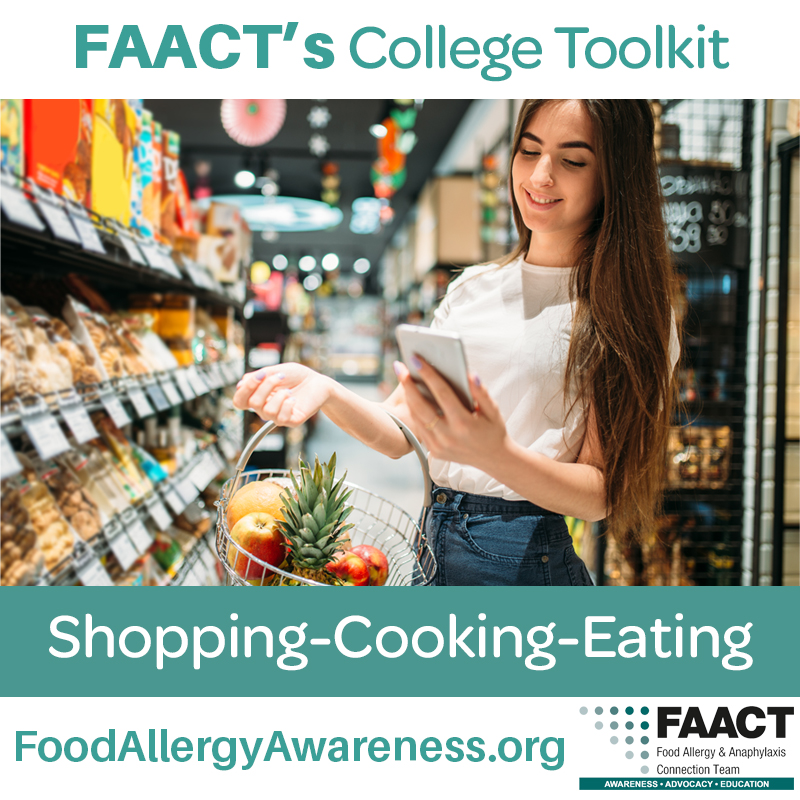FAACT's College Resource Center
Eating Cooking Shopping
Back to Category View
Shopping, Cooking, and Eating with Food Allergies
Moving off-campus can be exciting – and a little nerve-racking as food allergy responsibilities shift and put you in control of cooking and entertaining. Let us help you get comfortable with your new kitchen by offering a few tips.
Download FAACT's Shopping, Cooking, Eating Checklist.
Shopping
- Learn how to read product labels, including “hidden” terms used for certain allergens.
- You will generally want to avoid the bulk foods aisle and salad or hot food bars where cross-contact can occur.
- No label, do not purchase or eat!
- Get comfortable calling a manufacturer to confirm ingredients and cross-contact risk with your allergen, particularly if foods have generic ingredient lists such as “spices.”
- Understand that labels are not complete. Precautionary labeling – such as “may contain,” “made on shared lines,” or “made in the same facility as” – are VOLUNTARY. A manufacturer does not have to label for potential allergen risk if allergens are not an actual ingredient in that product.
- Manufacturers are only required to label packaged food products for the top nine allergens: peanut, tree nut, wheat, soy, egg, milk, fish, shellfish, and sesame.
- As of January 1, 2023, sesame was added as the top 9th allergen and is required to be plainly labeled on all packaged foods.
- U.S. Food and Drug Administration rules on allergen labeling do not include alcohol products or personal care products, both of which can contain common food allergens.
- Be wary of packaged foods sold at farmer’s markets, local shops, or other small producers who may use shared kitchens to create small-batch products. Ask about allergens in the foods as well as potential cross-contact. Fresh product is a safer purchase at a farmer’s market than something like baked goods.
Cooking
- Confirm your house rules for allergens: Are they allowed in the house? In the kitchen? How will you keep your food and ingredients separate?
- Consider maintaining an allergen-free shelf in the refrigerator and pantry if that is adequate for your needs.
- Don’t be afraid to ask for what you need, but be up front about it before you enter into a shared housing situation with friends. If your friend has a life-long love of PB&Js and you need them to keep peanut butter out of the house, that’s something that should be discussed before you sign a lease together.
- Consider how you will manage microwaves, toasters, and other shared appliances. Will these be exposed to roommates’ foods that contain allergens? Will you need to have a personal toaster, microwave, and other appliances to prevent cross-contamination?
- Visit FAACT’s Pinterest Page to find Allergy-Friendly Recipes, Cultural Allergy Friendly Recipes, and the Kid’s with Food Allergies Safe Eats Allergen-Friendly Recipe database.
- Always do your research for safe ingredients, read labels, and call manufacturers if needed.
Eating
- If someone else is cooking for you, ask about food preparation and cross-contact. Ask to read the ingredient labels for every item used in meal preparation (including condiments and sauces).
- Make sure you feel comfortable that the person cooking for you can keep you safe. If not, bring your own food or a dish to share, and bring your own serving utensils.
- If it’s not inconvenient for your host, one approach to consider is helping with food preparation so you can read labels and prevent cross-contact as you go. (It can also be fun to cook together!)
- Some college students will eat at home or on campus and then head over to friends’ houses to avoid potential food allergy issues.
- Carry allergen-safe energy bars, alternate nut or seed butters and crackers, and other satiating foods when you are away from home. Keep them stocked in your backpack or other bag that you use when you leave the house.
- Keep a list of allergen-friendly restaurants and eateries handy for suggestions when a group of friends wants to eat out.
- When in doubt, don’t eat it.
- Even if you’re not planning to actually eat at a friend’s house or a restaurant, you can still be exposed to allergens. Be sure to carry two epinephrine auto-injectors and your Allergy & Anaphylaxis Emergency Plan when you leave the house.